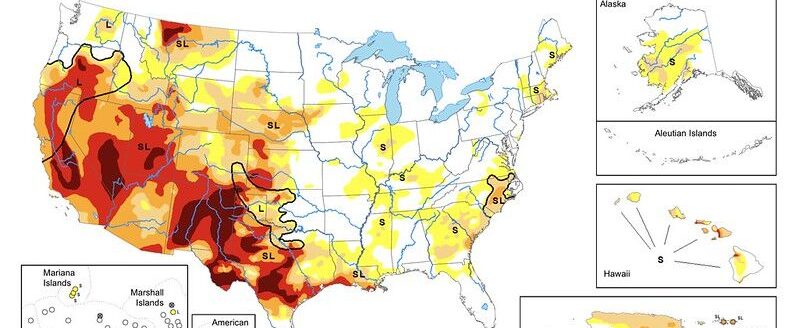Good stands should be focus for corn, soybean growers, technical agronomist says

As growers contemplate their spring corn and soybean planting decisions, particularly with headwind of drought conditions and higher fertilizer prices, a technical agronomist says farmers should stay patient and review all options.
“The overarching theme is how dry we are (as of April 20),” said Holly Thrasher with DEKALB Asgrow and based in Stafford, Kansas. Farmers who have irrigation are planting their crops and, depending on moisture level, there has been some dryland corn planted, too. Thrasher’s territory includes central and western Kansas.
The U.S. Department of Agriculture’s World Agricultural Supply and Demand Estimates planting intentions report indicated that nationwide 4% of corn acreage may shift to soybean acres, partly in response to fertilizer costs. Anhydrous ammonia, for example, is about $1,500 a ton—more than twice what it was for the 2021 growing season.
“It can be overwhelming with commodity prices high and input costs being so high and Mother Nature not being the kindest,” Thrasher said, adding growers have plant genetics and research from companies like DEKALB Asgrow with a team of agronomists and seed representatives who can help provide insight and answer questions.
Thrasher said depending on a grower’s location his options may be limited. “With the dry conditions some of these dryland corn acres that were questionable, the guys are starting to back off (with their planting decision). We are seeing guys looking into alternatives if they want to cut back on their dryland corn.”
Those options are limited in semi-arid areas. A dryland producer in Scott County, Kansas, is likely to look at sorghum, she said. Many of the producers she works with also have wheat acres and they will evaluate based on crop rotation practices.
“The past few years producers had Mother Nature on their side,” she said.
This planting season is different than recent years. The drought, demand and Russia’s invasion of Ukraine have all played a part in driving up grain prices.
Strong cash and futures markets traditionally signal a rise in corn acres but input costs have to be figured in, she said. “These are not easy decisions this year.”
A year ago growers had adequate rain but planted in cool conditions that lingered into early May. “It just seemed like the crop just sat in the ground for 10 days. We’re not in the same condition this year.”
Thrasher advises growers to slow down the speed of the planter to ensure the corn plant’s roots will be able to find moisture and the crop will have a good stand. “We are going to spend a lot of money to get this crop into the ground. There is a lot to be said for a good uniform stand. We want to make sure we are placing the seed the best we can and based on what Mother Nature gives us.”
Soybeans are selling for $16 a bushel and corn is at $7 a bushel, which provides opportunities for growers to be profitable. However, producers in western Kansas might not switch from corn to soybean acres because the soil contains a higher pH level. If a grower is considering switching crops, it makes having a soil quality test imperative, Thrasher said. While fertilizer and nitrogen costs are high they need to make sure they are looking at the big picture of their fertility programs; last year many had a tremendous crop so they should not overlook potassium, boron and sulfur levels.
A seed dealer recently told Thrasher about a successful farmer who made the comment, “These high commodity prices are getting a lot of folks excited, especially with the yields we were able to get last year, but we’ve got to grow the crop first and these conditions are entirely different than a year ago.”
Acreage for soybeans could increase in the central Plains because of the opportunity to double crop if additional moisture comes in May or early June on the non-irrigated acres, and that is a likely scenario after wheat is harvested from irrigated acres, she said. Producers in a corn-soybean rotation should also keep in mind any soybean-growing concerns they had the last time their field was planted to soybeans. Two years ago producer had a higher occurrence of sudden death syndrome due to the growing conditions. “Don’t make a decisions based on last year; consider prior years.”
“We need to make sure soybeans have a stand,” she said, adding that soybean performance works best as part of a long-term rotational plan.
As with corn the priority for soybean growers should be to have a good stand. As many growers have shifted to planting soybeans at lower populations, it is important to focus on the final stand to ensure growers have an adequate canopy to shade out weeds.
“Don’t overlook the final details,” she said. “Make sure you are going slow enough so that you can get all the seed into the ground when it looks like a dry year.
“From a herbicide standpoint use proper adjuvants and water volume. If you know it is going to be dry it can be a struggle with herbicide activation. Don’t shortchange yourself with inadequate application,” Thrasher said.
Sign up for HPJ Insights
Our weekly newsletter delivers the latest news straight to your inbox including breaking news, our exclusive columns and much more.
Dave Bergmeier can be reached at 620-227-1822 or [email protected].



